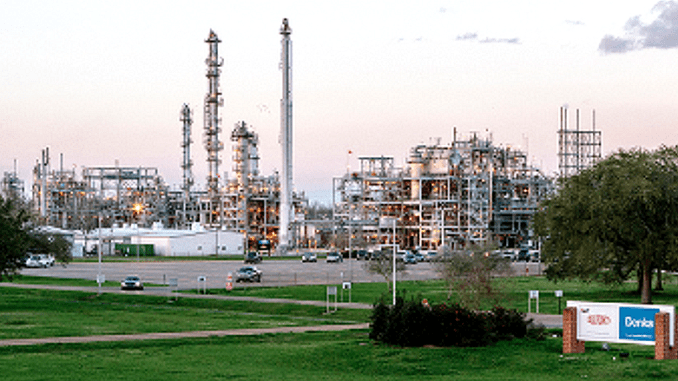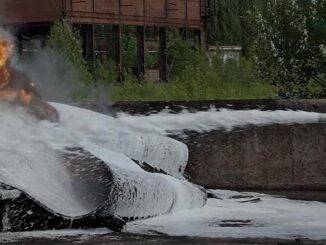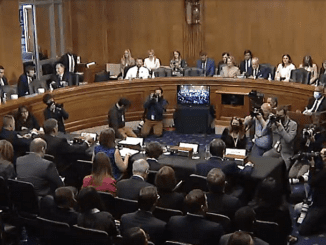
NEW ORLEANS, Louisiana, March 23, 2023 (ENS) – A federal court in Louisiana is being asked to order a Japanese company manufacturing neoprene in the state, to install pollution controls to reduce emissions of chloroprene, a pollutant that the U.S. Environmental Protection Agency found to be a likely human carcinogen back in 2010.
The EPA alleges that the chloroprene being released from the Denka Performance Elastomer LLC, facility could potentially lead to increased cancer risks in the surrounding community.
Chloroprene is emitted from the manufacture of neoprene. Invented by DuPont in 1931, neoprene is a flexible, synthetic rubber used for chemical and weather-resistant products such as wet suits, orthopedic braces and automotive belts and hoses. It also is used as a base resin in adhesives, electrical insulation and coatings.
The facility, at the small city of LaPlace in southern Louisiana, now is owned and operated by Denka Performance Elastomer, a newly formed joint venture in which Denka Co. Ltd., headquartered in Tokyo, Japan. owns 70 percent and Mitsui Co. Ltd., also based in Tokyo, owns 30 percent.
The joint venture was established as a result of their 2015 acquisition of DuPont’s neoprene business.
DuPont was the leading producer of neoprene in North America through manufacturing operations at the facility now at issue in the case. The factory is located between the cities of Baton Rouge and New Orleans on the east bank of the Mississippi River in St. John the Baptist Parish.
The government’s motion for preliminary injunction under the Clean Air Act, a request for immediate relief, was filed March 20 in the U.S. District Court for the Eastern District of Louisiana by the U.S. Environmental Protection Agency and the Justice Department. It follows the United States’ complaint filed on February 28, alleging an “imminent and substantial endangerment to the communities surrounding the facility as a result of Denka’s manufacturing operations.”
“Today’s motion asks the court to require Denka to take strong action to protect neighboring communities from the urgent dangers caused by its harmful emissions,” said Assistant Attorney General Todd Kim of the Justice Department’s Environment and Natural Resources Division. “This action shows our determination to address environmental justice concerns of overburdened communities and to protect children living and studying today near this facility.”
About 20 percent of the total population living within two-and-a-half miles of the Denka neoprene factory are children under the age of 18, and between 800 and 1,000 are children under the age of five. Children under the age of 16 are particularly vulnerable to mutagenic carcinogens like chloroprene, according to the EPA.
Denka’s chloroprene’s emissions reach more than 300 young children who attend the 5th Ward Elementary School, located within approximately 450 feet of Denka’s facility. Additionally, 1,200 children who attend East St. John High School, located about a mile-and-a-half north of Denka, are also exposed to the facility’s chloroprene emissions.
Denka defends its actions by citing a study published in November 2020 in the “Journal of Occupational and Environmental Medicine” that followed nearly 7,000 workers at chloroprene-handling
facilities across United States for 70 years and concluded “the risk of death from lung or liver cancer is unrelated” to exposure to the chemical.
The study reviewed lifetime data on over 1,300 employees of the neoprene production facility in St. John the Baptist Parish along with 5,500 employees of a facility in Louisville, Kentucky and found they experienced below-average rates for all cancer deaths compared with the U.S. and parish/county averages.
The 2020 study, authored by researchers from the University of Pittsburgh and funded by the International Institute of Synthetic Rubber Producers, follows a previous study published in 2007 with similar results. Other research completed by the Louisiana Tumor Registry shows residents living near the Louisiana plant do not experience elevated rates of those cancers compared with state averages.
But in 2010, EPA published its peer-reviewed assessment of chloroprene that concluded it is “likely to be carcinogenic to humans,” and that is the research the EPA relies on today.
“As regional administrator, I am committed to reducing exposure to chloroprene in St. John the Baptist Parish,” said Administrator Dr. Earthea Nance of EPA Region 6. “Transparent engagement with the community is a top priority because people who live near Denka deserve to understand the purpose of the motion filed today and what EPA hopes to achieve by bringing this Clean Air Act Imminent and Substantial Endangerment case.”
In addition to chloroprene, Denka admits to the emission of substances including: “greenhouse gases, such as CO2, SOx (sulfur oxides), NOx (nitrogen oxides), soot and dust, BOD (biochemical oxygen demand), COD (chemical oxygen demand), and other substances designated by the Pollutant Release and Transfer Register Law.
“We will actively introduce equipment to remove substances that have a negative environmental impact, comply with voluntary management standards that are stricter than those set by relevant laws and regulations, and continue to strive to reduce the amount of environmental load substances,” Denka said in an October 2022 statement.
The EPA recognizes that Denka has implemented several control measures at the plant under an agreement with the Louisiana Department of Environmental Quality.
The results of EPA’s ambient air monitoring taken since these control measures were implemented show substantial reductions in chloroprene in ambient air at all six EPA monitoring sites
“All communities deserve to breathe fresh, clean air; it is one of EPA’s top priorities as we work to protect human health and the environment,” said EPA Administrator Michael Regan. “This is another action that sends a clear message that the Biden-Harris Administration is committed to the health and safety of St. John the Baptist Parish, and I will continue to pledge that EPA will use all legal remedies available to reduce harmful air pollution in this community.”
For more information on EPA’s actions to reduce chloroprene emissions from the Denka facility: www.epa.gov/la/laplace-st-john-baptist-parish-louisiana.
Featured image: The Denka neoprene factory at LaPlace, Louisiana. (Photo courtesy Denka Performance Elastomer LLC)



